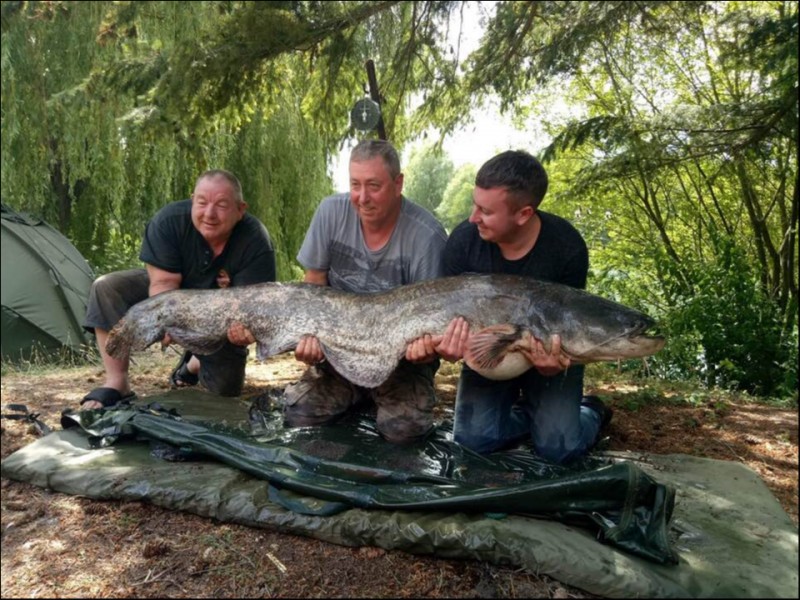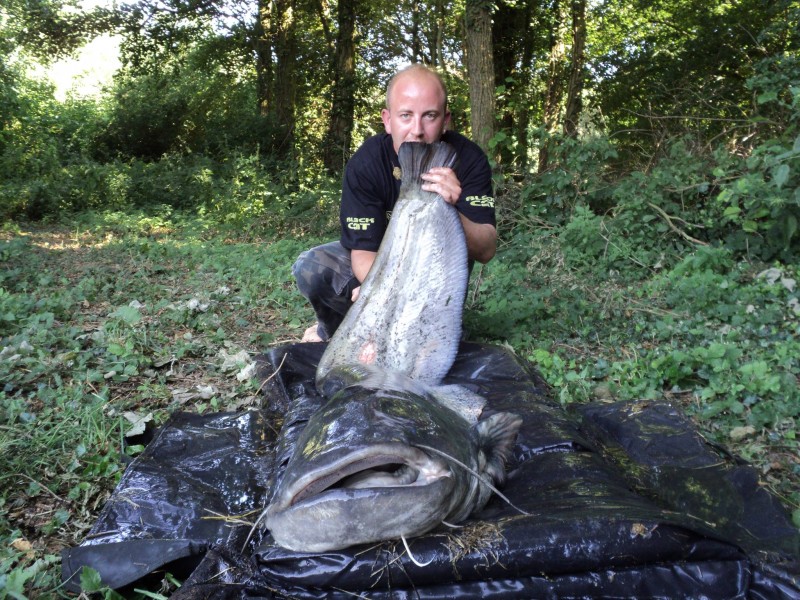Targeting monster catfish? Make sure you have the right tools for the job…
Last year, I was fortunate to attend Catmaster Tackle’s annual social at Oakwood Park Lakes, in Norfolk.
As an out-and-out carp angler, I figured – like many before and since – that, with a few tweaks here and there, my existing kit would prove a match for whatever the big fish water could throw at me.
And like many before and since, I was mistaken.

A 100lb+ catfish from Molyneux. This French lake is ideal for both carp and catfish seekers, located only 2hrs 45 from the port of Calais.
Watching the great and the good of the catfishing fraternity boating out 2lbs+ fish baits – and, even more significantly, later removing said baits from the cavernous gobs of 70lbs+ beasts – led me to wonder how:
- cats, being near-blind, could possibly locate a tiny 15mm hookbait amid truckloads of donkey choker halibut pellets, and rakes of prey fish; and
- if indeed they did, how on God’s green earth we could ever hope to land them, on even stepped-up carp kit?
Of course, they do; and we do: accidental captures of some very large cats – by under-gunned and ill-equipped carp anglers – are quite common. But catching and landing big fish consistently – and by design… Well, that’s an altogether different matter.
And besides: do you really want to take chances with those precious HiS rods and Basia reels?
To my mind, the creaking of overpriced carbon and scream of tortured gears rather takes the fun out of the fight.
The question then is: can you afford to invest in a completely new set-up, for the odd trip to France?
Well, you know what? You really can. And that modest additional expense could make that trip far more worthwhile; ensuring you hook more cats – and bank them too.
So, let’s start with the pricey stuff: rods.
As with all branches of the sport, you can spend as much as you like on ‘looking the part’; with rods from Catmaster, Catfish Pro, Century, Free Spirit and others topping many a Wish List.
And running to hundreds of pounds each.
The good news: a set of more ‘budget sensitive’ rods could set you back under £100 for three. And will do much the same job.
Best example, in my humble opinion: NGT’s 10’ Dynamic Catfish Rod – a brute of a tool with a casting weight of up to 200g, which you should be able to pick up for around… £30.
Yes, really.

Now, in the spirit of full disclosure, I should mention: having a business that buys and sells used fishing tackle, I’m rather shooting myself in the foot here.
The amount of top spec used-once kit we buy from would-be anglers who spend a fortune on gear for a French trip – then ‘bin it’ when they realise it’s not for them – beggars belief.
But, really: why would you spend the thick end of £400 on specialised hardware which you may only use, at the most, once or twice a year?
If the wels bug bites, then fine: upgrade. (And sell me your old kit!) But otherwise, you’d be better off investing your hard-earned in the stuff that really counts: your holiday venue, terminal tackle and bait. Oh, and, of course, reels.
Fact is, cats have a habit of transforming the most expensive reels to stripped-gears and scrap metal. So reel choice is all about strength and reliability.
Specifically, you’re looking for a reel that’s tough as nails, capable of holding plenty of thick-ish line, with a proven, reliable clutch. And here again there’s no reason to break the bank.
Whilst an industrial strength big pit will do the job, a heavy-duty sea fishing reel will do it just as well. For a fraction of the price.
So, shy away from Shimano et al and you’ll get a good chunk of change out of £100 for three.

Which brings us to…
Landing gear!
Clearly, your regular 42” carp net isn’t going to accommodate a 6’plus leviathan. So what’s to be done?
Well, there are any number of larger – 60”-70” – cat nets on the market. They are however rather heavy. And they’re not what you’d call cheap – running to £100 or more.
Which explains why so many anglers choose instead to ‘glove’ their fish: gripping the beaten fish’s bottom jaw with a gloved hand and dragging it on to the bank using an oversized unhooking mat.
The technique is not, however, for the faint hearted. If a cat chooses to twist at the wrong moment, you’re looking at a broken wrist.
Similarly, you should make sure you have a good idea of the hook hold before you embark on a nocturnal tug of war: a 2/0 Eagle Wave in the thumb is to be avoided if at all possible.
And however good the French health service may be, a trip to A&E could take the edge off your holiday experience.
So, for the inaugural expedition, you might consider biting the bullet, and investing in a specialist net from the likes of Catmaster or Catfish Pro.
Much the same applies to your weighing gear.
You will simply not be able to get an accurate weight for a big cat without a suitable sling, and tripod.
So unless you’re happy with a ‘best guess’, you will need a purpose made sling from one of the usual suspects.
Those lovely people at NGT also do a great tripod which, though rather heavy, can usually be picked up for around £30.
And that’s you done for catfish hardware.
Your regular carp pod or bankstick set-up and alarms will be fine. Indeed, they’re essential. Cats are very much nocturnal in nature, most active between dusk and dawn.
Which is great for you, if you’re booking a family break on a venue with accommodation – meaning you can devote your time to your nearest and dearest by day; secure in the knowledge that the best, fishing wise, is to come once the sun goes down.
Win:win!
For more information on catfishing in general – and targeting bigger French beasts in particular – contact the Catfish Conservation Group. Or get in touch with Ron at Catmaster Tackle, who’s always more than happy to share his decades’ experience targeting the species at home and overseas.
Steve Calder

Comments